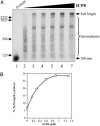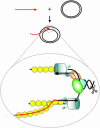Reconstitution of recombination-dependent DNA synthesis in herpes simplex virus 1
- PMID: 12928502
- PMCID: PMC193539
- DOI: 10.1073/pnas.1534569100
Reconstitution of recombination-dependent DNA synthesis in herpes simplex virus 1
Abstract
The repair of double-strand DNA breaks by homologous recombination is essential for the maintenance of genome stability. In herpes simplex virus 1, double-strand DNA breaks may arise as a consequence of replication fork collapse at sites of oxidative damage, which is known to be induced upon viral infection. Double-strand DNA breaks are also generated by cleavage of viral a sequences by endonuclease G during genome isomerization. We have reconstituted a system using purified proteins in which strand invasion is coupled with DNA synthesis. In this system, the viral single-strand DNA-binding protein promotes assimilation of single-stranded DNA into a homologous supercoiled plasmid, resulting in the formation of a displacement loop. The 3' terminus of the invading DNA serves as a primer for long-chain DNA synthesis promoted by the viral DNA replication proteins, including the polymerase and helicase-primase. Efficient extension of the invading primer also requires a DNA-relaxing enzyme (eukaryotic topoisomerase I or DNA gyrase). The viral polymerase by itself is insufficient for DNA synthesis, and a DNA-relaxing enzyme cannot substitute for the viral helicase-primase. The viral single-strand DNA-binding protein, in addition to its role in the invasion process, is also required for long-chain DNA synthesis. Form X, a topologically distinct, positively supercoiled form of displacement-loop, does not serve as a template for DNA synthesis. These observations support a model in which recombination and replication contribute toward maintaining viral genomic stability by repairing double-strand breaks. They also account for the extensive branching observed during viral replication in vivo.
Figures





Similar articles
-
Role of protein-protein interactions during herpes simplex virus type 1 recombination-dependent replication.J Biol Chem. 2004 May 21;279(21):21957-65. doi: 10.1074/jbc.M400832200. Epub 2004 Mar 16. J Biol Chem. 2004. PMID: 15026409
-
In vitro strand exchange promoted by the herpes simplex virus type-1 single strand DNA-binding protein (ICP8) and DNA helicase-primase.J Biol Chem. 2002 Apr 26;277(17):15182-9. doi: 10.1074/jbc.M109988200. Epub 2002 Feb 6. J Biol Chem. 2002. PMID: 11832483
-
Requirement for double-strand breaks but not for specific DNA sequences in herpes simplex virus type 1 genome isomerization events.J Virol. 1994 Jan;68(1):34-47. doi: 10.1128/JVI.68.1.34-47.1994. J Virol. 1994. PMID: 8254746 Free PMC article.
-
Herpes simplex virus type 1 replication and recombination.Biochimie. 1995;77(10):787-95. doi: 10.1016/0300-9084(96)88197-1. Biochimie. 1995. PMID: 8824776 Review.
-
Mediator proteins orchestrate enzyme-ssDNA assembly during T4 recombination-dependent DNA replication and repair.Proc Natl Acad Sci U S A. 2001 Jul 17;98(15):8298-305. doi: 10.1073/pnas.131007498. Proc Natl Acad Sci U S A. 2001. PMID: 11459967 Free PMC article. Review.
Cited by
-
Herpes simplex virus type 1 C-terminal variants of the origin binding protein (OBP), OBPC-1 and OBPC-2, cooperatively regulate viral DNA levels in vitro, and OBPC-2 affects mortality in mice.J Virol. 2007 Oct;81(19):10699-711. doi: 10.1128/JVI.01213-07. Epub 2007 Jul 18. J Virol. 2007. PMID: 17634223 Free PMC article.
-
Proteomics of herpes simplex virus replication compartments: association of cellular DNA replication, repair, recombination, and chromatin remodeling proteins with ICP8.J Virol. 2004 Jun;78(11):5856-66. doi: 10.1128/JVI.78.11.5856-5866.2004. J Virol. 2004. PMID: 15140983 Free PMC article.
-
Cytomegalovirus replicon-based regulation of gene expression in vitro and in vivo.PLoS Pathog. 2012;8(6):e1002728. doi: 10.1371/journal.ppat.1002728. Epub 2012 Jun 7. PLoS Pathog. 2012. PMID: 22685399 Free PMC article.
-
RNA binding and R-loop formation by the herpes simplex virus type-1 single-stranded DNA-binding protein (ICP8).Nucleic Acids Res. 2004 Aug 25;32(15):4576-84. doi: 10.1093/nar/gkh797. Print 2004. Nucleic Acids Res. 2004. PMID: 15329407 Free PMC article.
-
Circularization of the herpes simplex virus type 1 genome upon lytic infection.J Virol. 2005 Oct;79(19):12487-94. doi: 10.1128/JVI.79.19.12487-12494.2005. J Virol. 2005. PMID: 16160176 Free PMC article.
References
Publication types
MeSH terms
Substances
Grants and funding
LinkOut - more resources
Full Text Sources
Other Literature Sources

